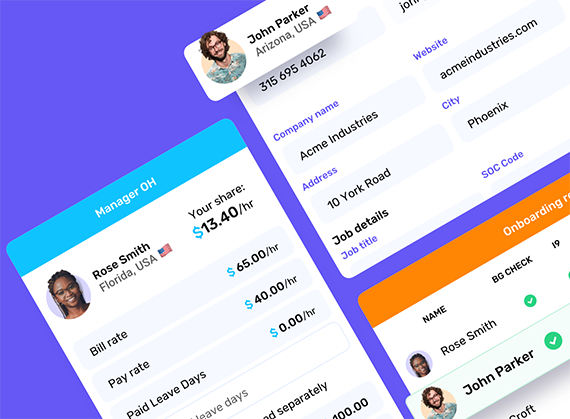When you’re a recruiter sourcing contract candidates, placing a candidate is just the beginning of the journey. A recruiter’s relationship with both the client and the contractor doesn’t end once the placement is made—it’s vital to maintain regular communication to ensure the ongoing success of the engagement. This is true whether your firm is the employer of the contractor, or you’re partnering with an Employer of Record (EOR) service to support the candidate. Frequent check-ins with contract workers can strengthen your relationships with both the contractor and client, prevent issues before they escalate, and increase the likelihood of contract renewals or extensions.
Why Regular Check-Ins Matter
- Contractor Satisfaction: Contractors are often working in unfamiliar environments, adjusting to new cultures, teams, and expectations. Regular communication reassures them that they are supported and valued.
- Issue Resolution: If any issues arise—whether related to the role, compensation, or work environment—frequent check-ins provide an opportunity for the contractor to voice concerns early before they become bigger problems.
- Client Feedback: Checking in with the contractor is a great way to gather insights about the client’s work environment and to identify areas where your client may need additional support.
- Reinforcing Your Role: Regular interactions demonstrate that you’re invested in both the client’s and the contractor’s success. This strengthens your role as a trusted partner to both parties.
How Often Should You Check In?
To maintain a healthy relationship, a structured check-in process is key. Here’s a recommended sequence of when and how often a recruiter should check in with a contractor during their assignment:
1. Pre-Placement Check-In
- Timing: A few days before the contractor’s start date.
- Purpose: Ensure the contractor is ready and has everything they need to succeed on day one, such as onboarding details, necessary equipment, and knowledge of expectations. This also reassures the client that the contractor is prepared.
- Method: Phone or video call to ensure personalized attention and clarity.
2. Day 1 Check-In
- Timing: The contractor’s first day on the job.
- Purpose: Confirm that the contractor arrived, was onboarded properly, and is set up for success. This is also a great opportunity to field any immediate concerns or issues.
- Method: A brief phone call or text message.
3. Week 1 Check-In
- Timing: At the end of the contractor’s first week.
- Purpose: After the first few days, touch base to see how the contractor is adjusting. Ask about their experience with the client and work environment, and gauge any early challenges they may face.
- Method: Phone or video call for a more in-depth conversation.
4. Bi-Weekly or Monthly Check-Ins
- Timing: Every two weeks during the first month, and then monthly afterward.
- Purpose: Continue to monitor how the contractor is settling into the role. Ask about workload, any potential issues, and whether their expectations are being met. This will also allow you to provide any support or guidance as needed.
- Method: A mix of phone calls and emails depending on the contractor’s preference.
5. Mid-Contract Check-In
- Timing: Halfway through the contract.
- Purpose: Review the contractor’s overall performance, whether they’re satisfied with the role, and if there are opportunities for an extension or future contracts. Discuss any potential issues with the client, and check if the contractor is looking for changes or feedback from the client or the recruiter.
- Method: Phone or in-person (if possible) to solidify a deeper connection.
6. End-of-Contract Check-In
- Timing: Two weeks before the contract ends.
- Purpose: Discuss next steps—whether the contractor is interested in extending the contract, transitioning to a permanent role, or moving on. This is especially important if you want to capitalize on a conversion fee opportunity. This conversation also helps with planning any necessary actions for a smooth transition for the client.
- Method: Phone or in-person, as this conversation often involves critical next steps.
7. Post-Contract Follow-Up
- Timing: 1-2 weeks after the contract ends.
- Purpose: Regardless of whether the contractor renews or ends the engagement, a follow-up is essential. If the contract ended, ask for feedback on their experience, both with the client and with you as a recruiter. If they renewed or transitioned, keep the conversation open to discuss how you can continue to support them.
- Method: Phone call or email.
Benefits of Structured Check-Ins
By following this structured approach, you build trust and maintain open lines of communication with your contractor, leading to:
- Higher contractor retention: Contractors who feel supported are more likely to stay engaged and satisfied with their roles, reducing turnover and increasing contract renewals.
- Improved client satisfaction: Clients appreciate proactive communication and knowing that their recruiter is attentive and responsive to the contractor’s needs.
- Insightful feedback loops: These regular conversations can uncover insights into the client’s work environment and the contractor’s experience, allowing you to continuously refine your placement strategy.
Final Thoughts
Checking in on contractors isn’t just a best practice—it’s a way to elevate the quality of your placements, improve client and contractor satisfaction, and solidify your reputation as a responsive, trustworthy recruiter. With a consistent and thoughtful check-in sequence, you can stay ahead of any potential issues, ensure ongoing engagement, and create lasting relationships with both contractors and clients.





